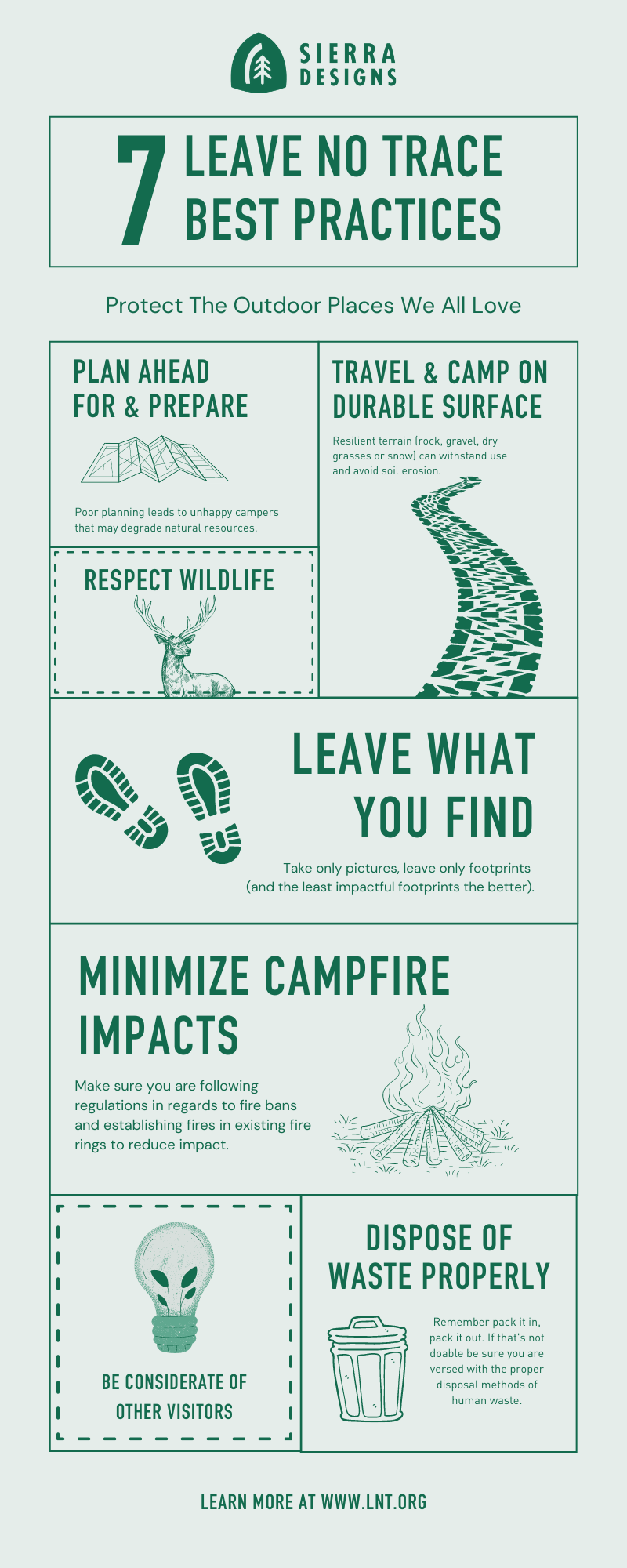With over 100 million visitors on more than 10 billion outings in the U.S. each year, our love for the outdoors can take a toll. That’s why we all must do our part to reduce our impact. If you’re headed out to the backcountry this summer make sure you’re following the 7 Leave No Trace Principles. More information at www.lnt.org.

Plan Ahead and Prepare
Poor planning can lead to unhappy campers that may degrade natural resources. Making sure you have knowledge about your destination, conditions and needs will help reduce your impact.
- Be aware of regulations and other concerns in the areas you are planning to visit (Is a fire ban in effect? Then make sure you have a gas stove)
- Be prepared for the conditions. Without proper attire or equipment you may make decisions that negatively impact the environment and the safety of others.
- Prepping food by removing it from commercial packaging can reduce bulk and waste when out on the trail.
- Know where you are camping. Poor campsite selection can lead to unnecessary resource damage.
Travel & Camp On Durable Surfaces
Trails and campsites are created for a reason, concentrating traffic to a specific location minimizes widespread damage. When hiking or camping must be done off trail be sure that the surface is as durable as possible – rock, sand, gravel and even ice / snow are the most resilient surfaces to human impact. When picking a campsite avoid camping close to water and trails, and select a site which is not easily visible to others. Camping 200 feet (70 adult steps) away from the water’s edge is recommended because it allows access routes for wildlife. Be sure to confine impact to places which already show use and avoid enlarging the area of disturbance and vary your routes around camp to minimize the amount of trampling and compaction in specific area.
Respect Wildlife
The ecosystem of a location is very sensitive. Be sure to respect wildlife by avoid encounters as much as possible. The last thing you want to do is harm yourself or wildlife through an interaction. Keep pets on leash and avoid animals during sensitive times (mating, nesting, raising young or winter).
Leave What You Find
The best campsites are found, not made.
- Minimize campsite alterations
- Avoid damaging live trees and plants
- Leave natural objects and cultural artifacts
Minimize Fire Impacts
When possible camp stoves are a far less impactful cooking option than building fires.
- Where fires are permitted, use established fire rings, fire pans or mound fires.
- Create fires in areas where wood is abundant, choose not to have a fire in areas where wood is not easy to find and may be obtained through destructive processes.
- Burn all wood to ash, grind small coals to ash between your gloved hands, thoroughly soak with water, and scatter the remains over a large area away from camp. Ashes may have to be packed out in river corridors.
- Scatter unused wood to keep the area as natural looking as possible.
- Don’t bring firewood from home, as it could introduce new pests and diseases to areas. Buy it where you burn it.
Be Considerate Of Other Visitors
Most people got out to nature to experience the feeling of solitude and peacefulness. Treat others how you’d like to be treated when enjoying nature.
Dispose Of Waste Properly
Remember pack it in, pack it out. If that’s not doable be sure you are versed with the proper disposal methods of human waste.
- Deposit solid human waste in catholes dug 6 to 8 inches deep, at least 200 feet from water, camp and trails. Cover and disguise the cathole when finished. If camping in the area for more than one night, or if camping with a large group, cat hole sites should be widely dispersed. Avoid areas where water visibly flows, even if they are dry at the moment. Select a site that will maximize exposure to the sun in order to aid decomposition.
- Wastewater is another form of waste that needs to be considered. Be sure to carry water 200 feet away from streams or lakes to wash dishes or yourself. If using soap make sure it is biodegradable soap. When finished scatter the strained wastewater.



